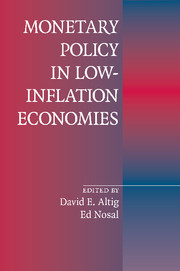Book contents
- Frontmatter
- Contents
- Contributors
- Acknowledgments
- Introduction
- 1 The Welfare Cost of Inflation in the Presence of Inside Money
- Commentary
- 2 An Open-Economy Model of Endogenous Price Flexibility
- Commentary
- 3 Efficient Inflation Targets for Distorted Dynamic Economies
- Commentary
- 4 Inflation and Welfare in Models with Trading Frictions
- Commentary
- 5 Good versus Bad Deflation: Lessons from the Gold Standard Era
- Commentary
- 6 Monetary Policy Orientation in Times of Low Inflation
- Commentary
- 7 Observations on Disinflation in Transition Economies
- Commentary
- 8 Inflation and Financial Market Performance: What Have We Learned in the Last Ten Years?
- Commentary
- Index
6 - Monetary Policy Orientation in Times of Low Inflation
Published online by Cambridge University Press: 26 January 2010
- Frontmatter
- Contents
- Contributors
- Acknowledgments
- Introduction
- 1 The Welfare Cost of Inflation in the Presence of Inside Money
- Commentary
- 2 An Open-Economy Model of Endogenous Price Flexibility
- Commentary
- 3 Efficient Inflation Targets for Distorted Dynamic Economies
- Commentary
- 4 Inflation and Welfare in Models with Trading Frictions
- Commentary
- 5 Good versus Bad Deflation: Lessons from the Gold Standard Era
- Commentary
- 6 Monetary Policy Orientation in Times of Low Inflation
- Commentary
- 7 Observations on Disinflation in Transition Economies
- Commentary
- 8 Inflation and Financial Market Performance: What Have We Learned in the Last Ten Years?
- Commentary
- Index
Summary
INTRODUCTION
The past 20 years have seen a general reduction in inflation rates to very low levels everywhere in the OECD (Organisation for Economic Co-operation and Development). The general return to (almost) price stability reflects a shift in monetary policy philosophies from an attitude of actively exploiting the Phillips curve to manage the macroeconomy to a more modest one aimed at stable monetary conditions and low inflation. This shift in monetary policy philosophies has had its repercussions in the move to more independent central banks and the adoption of rules-based regimes such as inflation targeting. In Europe, it has its visible reflection in the European Union (EU) Treaty of 1997 and in the charter of the European Central Bank (ECB), which, for now, has made price stability the principal goal of monetary policy.
The changing pattern of monetary policy has been accompanied by a change in the view most economists take on the inflationary process and the role of monetary policy in it. Twenty years ago, it was widely accepted that the main cause of inflation was excessive money growth and that to keep inflation down, the central bank had to control the growth rate of money. Today's New Keynesian consensus model of monetary policy transmission does not even make the role of money in determining the rate of inflation explicit. Instead, it sees the main role of the central bank as setting an interest rate that affects the output gap, which, in turn, determines the rate of inflation through the Phillips curve.
- Type
- Chapter
- Information
- Monetary Policy in Low-Inflation Economies , pp. 181 - 206Publisher: Cambridge University PressPrint publication year: 2009
- 1
- Cited by

